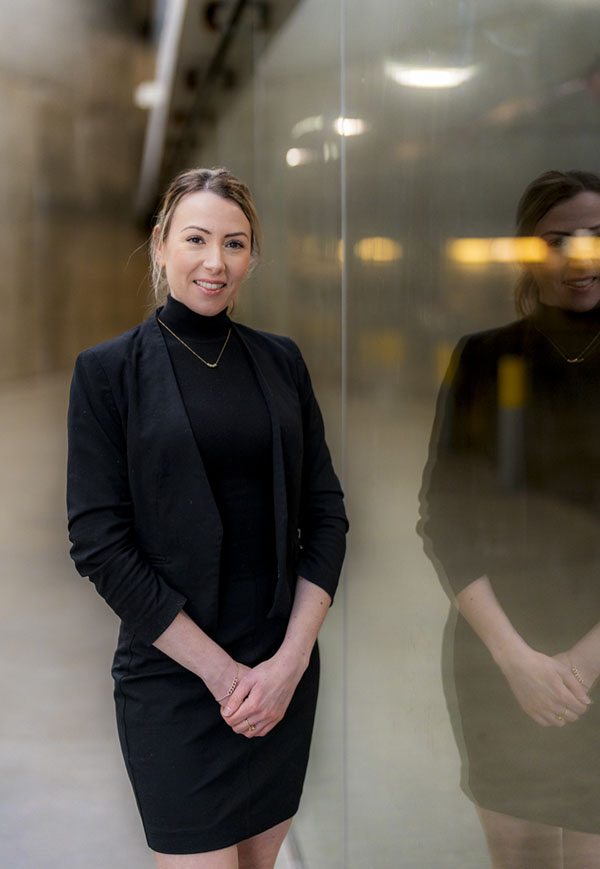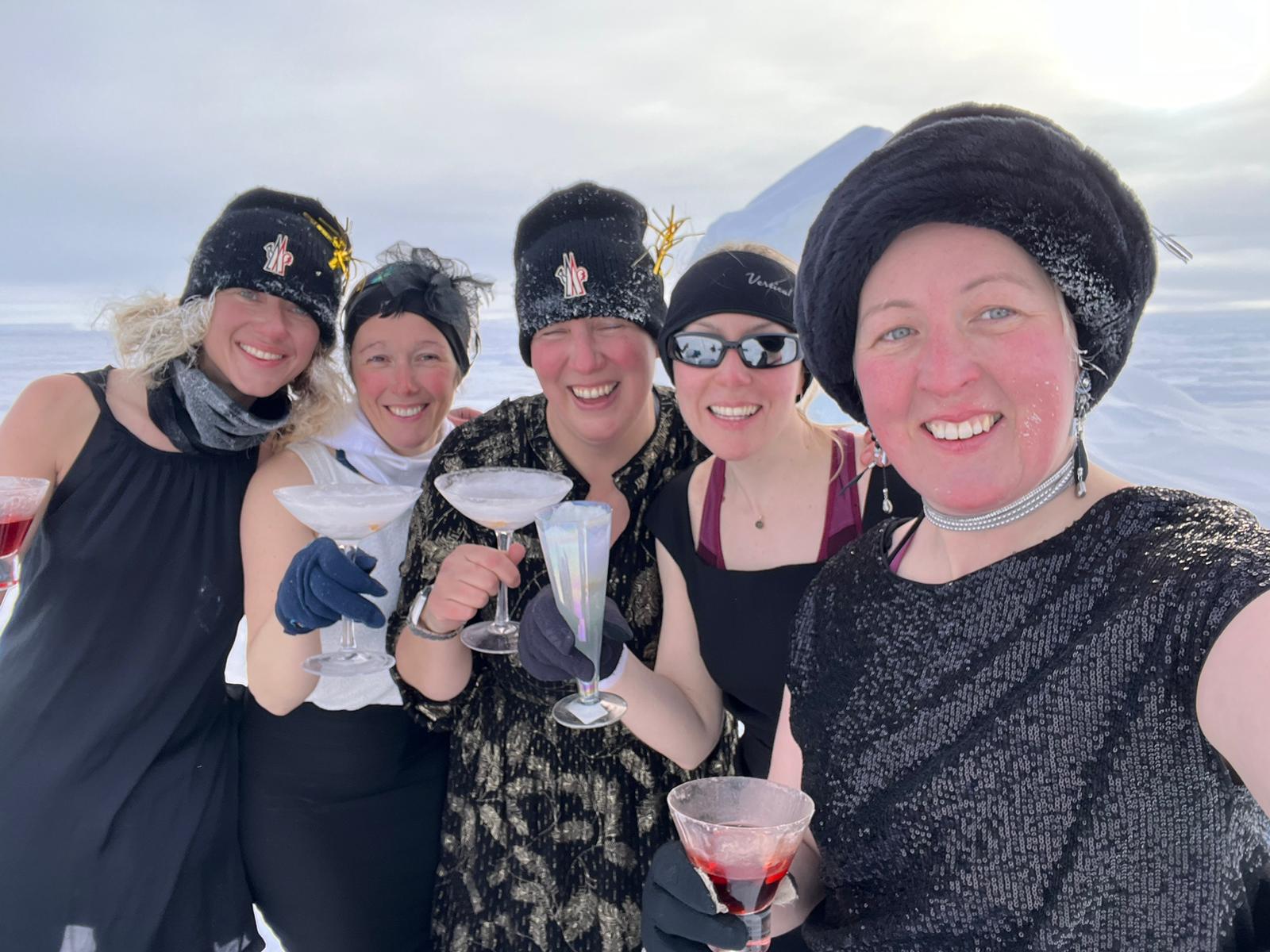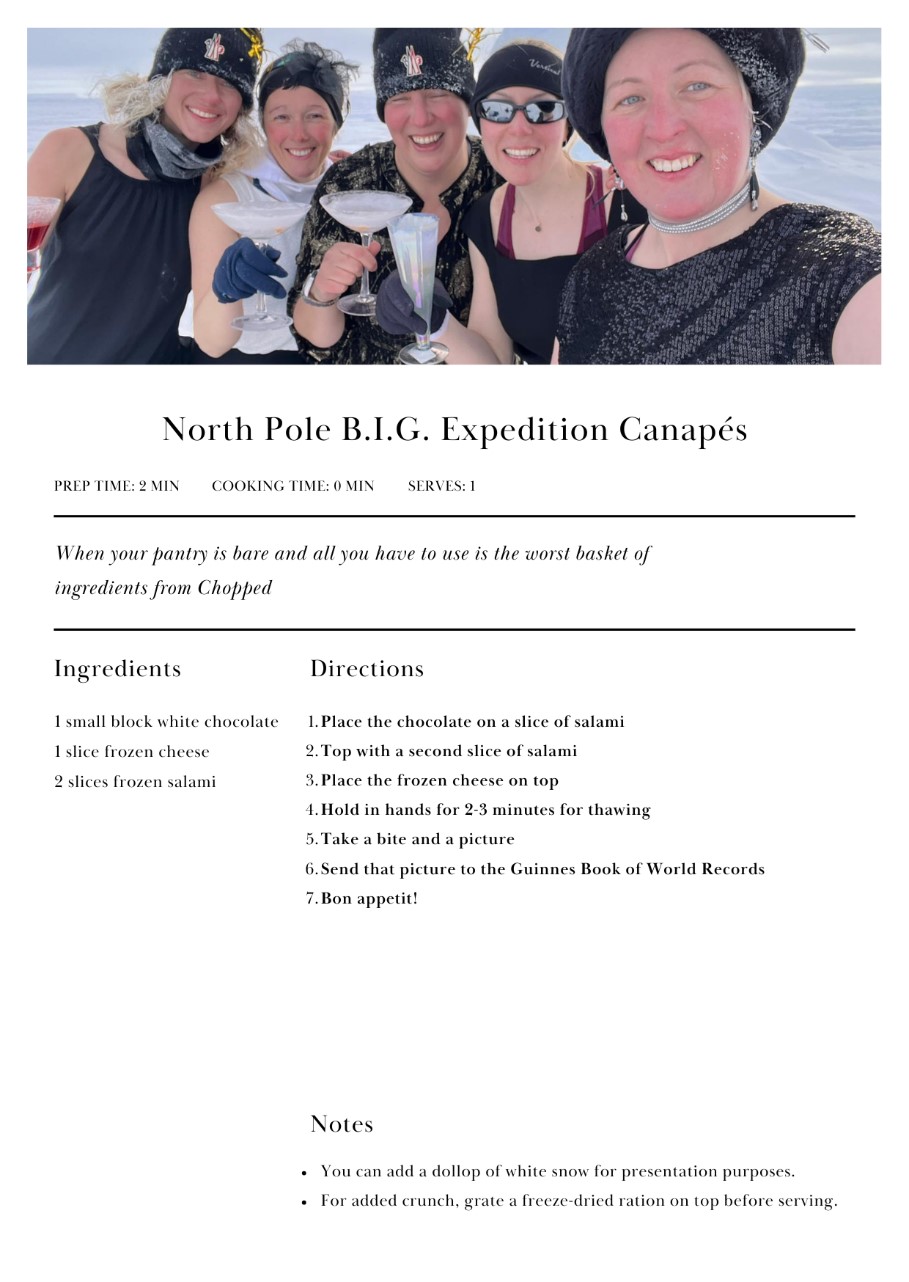
Laura Thomas-photo by Erik McRitchie

B.I.G. at the North Pole photo by Edel Kieran
Training astronauts for space flight requires a huge team, including psychologists who can help to prepare them for the close quarters and isolation for long periods of time. Laura Thomas is not only one of those psychologists, she has also experienced similar close quarters and isolation with all-female expeditions to places like the North Pole.
We kick off 2025’s Psychology Month: Women in Science with a look at Laura’s work, her travels, and the requirements for setting a Guinness World Record!
I am often in awe of the people I interview, many of whom are remarkably accomplished and doing work that matters to the world. At times, I’m even a little bit envious, in that I would love to have been a part of some of those projects. I confided as much in Laura Thomas toward the end of our Zoom meeting, but told her she is an exception. Not that I’m not in awe of everything she does – I certainly am. But I am not the least bit envious. I would love to have been a part of the World’s Most Northerly Cocktail Party (scroll down for canapé recipe). But very few forces on Earth could have convinced me to be part of the intrepid group that skied, camped, and braved the shifting ice of the North Pole for days in order to get there.
Laura Thomas, on the other hand, couldn’t wait. In 2016, she was a counseling psychologist in the UK and an afficionado of adventure tourism. She began to take an interest in extreme environments, and attended a lecture by British explorer Felicity Aston, MBE. They chatted, and before long Laura was joining her on a trekking trip to Ethiopia. A few years later, she was headed to the North Pole, living in Calgary, and going in a whole new direction with her career.
Trekking to the North Pole seems like a long way to go…because it is. Consider this – the distance to the current magnetic North Pole from Alert, Nunavut, the northernmost inhabited place on Earth, is a little over 800 km. The distance from the Earth to the International Space Station is only 400 km.
Do you ever look up at the ISS as it passes over us, and wonder what the astronauts are doing? Some kind of science, one assumes, and lots of freeze-dried cuisine? Some kind of exercise that looks like that scene in 2001: A Space Odyssey? As Canadians, we know that some of them practice David Bowie tunes on guitars, since there’s no way Chris Hadfield was able to do that performance without practice.
Laura knows what the astronauts are doing. Or, at least, what they could do. And how they can do it, what with the long months of isolation, the forced intimacy of close quarters, and the physical changes one undergoes while in those conditions. Laura studies people, and their behaviour, in extreme isolation.
Laura is the co-founder of PARSEC Space, a new company that exists to train commercial space operators. She works alongside scientists, pilots, and engineers from the likes of NASA, ESA, and the military to select, train, and develop the next generation of astronauts. These will not necessarily be space travelers who will be going to the ISS. There are many other plans for space exploration. Says Laura,
“Rather than space tourism, per se, we’re focused more on research and payload specialists. People who are going to go up and offer their expertise for various projects and research that’s being done in space. The thing about government agency astronauts is that it takes a huge amount of time and money to train them. And they’re generalists. They’re not necessarily the experts in the kinds of technology they’re trialing or the experiments they’re running up there. In the future there will be a lot more space research.”
Pharmaceutical companies, for example, want to test new medications in space. Things act differently in space because of the conditions. In microgravity, bacteria grows differently. There could be a lot of benefits from observing how things grow in the absence of gravity. Manufacturing companies are also leaning toward testing their products and systems in space. NASA is looking to build a permanent base on the moon, which would undoubtedly include a significant research facility.
When that happens, PARSEC will be there to train the astronauts who will go there, and Laura will be assessing the mental fitness of participants and training them to handle the rigours of space travel.
“The qualities that are desirable in an astronaut have changed a little over the years. We call it the ‘new right stuff’. Previously, missions were relatively short, so you needed people with the technical skills to get the job done. But if you’re looking at people surviving and thriving in space over the longer term, with that level of extreme isolation and confinement, you need to look at how people cope. Their innate resilience, their capacity to cope with different types of stressors, how well they get on with other people, how well they function within a team. The so-called softer side, the personality-related traits, become much more important.”
Laura can’t just go up to space to watch people and guide them in that exact environment, at least not yet, so analogue environments on Earth (those with the most similarities to conditions in space) will have to do. Subterranean cave systems, remote jungles and mountains, and of course polar regions. Laura, for example, was the crew psychological officer on one such “analogue” in the Mojave Desert where they were isolated for ten days.
“It was really interesting, we were in this habitat, which was a series of pods, basically. Eight women by ourselves, isolated in the Mojave and living like astronauts. We had a medical officer, an engineering officer, a crew commander. Our daily routine involved exercises and activities that we would need to do as astronauts.”
While there, Laura observed and assisted her crewmates to ensure everyone was coping well, identifying the best interventions and adaptations in that setting. It was the first ever analogue that was all-female, attracting scientists from all over the world. There were crew members from Jordan, New Zealand, the U.S. and elsewhere. It enabled Laura to further her research into salutogenesis in analogue environments. Salutogenesis refers to a focus on the factors that promote health, well-being, and positive outcomes for people.
A lot of people have very positive experiences in these kind of environments. Often, astronauts who go into space can look back on the Earth through the Cupola windows, which can create a profound feeling of transcendence. They come back to Earth with a different sense of the planet’s beauty and it’s fragility and develop more compassion for humanity. This is called the ‘overview effect’, and it lasts much longer than just the moment an astronaut looks out the window of a spacecraft. States of extreme awe and transcendence have also been seen in terrestrial-based analogues.
“You can see from a distance that the Earth is all landmass and water. We can’t tell where the border to one country begins and another ends. It gives you a real conviction that we’re all part of the same thing.”
There have also been reports of increases in feelings of personal strength, better stress resilience, and long-term physical health outcomes. Sometimes, the more stressful the situation is for the participants, the more profound the changes to their psyche. Laura says it’s almost like there’s a threshold of stress that must be met for the more positive benefits to take effect.
It’s hard to imagine an expedition more stressful than one to the North Pole. In 2024, Laura and her fellow explorers, all women, set out to take ice, snow and water samples at the 1996 position of the magnetic North Pole. The B.I.G. (Before It’s Gone) expedition had been planned since 2020, but delays caused by COVID and the Russian invasion of Ukraine meant that some team members had to drop out and Laura could step in.
Their team, led by British explorer Felicity Aston, MBE, trained in cross-country skiing in Norway and Iceland for weeks. Then they flew into Iqaluit, then to Resolute Bay, then to Isachsen – an abandoned weather station from the 70s which was the closest landing strip to the magnetic pole. Each of those plane flights was delayed by severe weather, which truncated the time they had to set off. On skis, pulling their equipment in their sleds, they headed toward the pole.

There were more delays along the way. Terrible weather had them stuck in their tents for almost three days. Despite being physically exhausted and seriously dehydrated, they had to push forward anyway to get ahead of an incoming storm. The team was always on lookout, for both shifting ice and polar bears. Says Laura,
“It’s an experience, but it’s hard. Being in those environments, anyone will tell you it’s hard. You need to have the right gear, but even then it’s brutal. You’re basically out there where everything’s trying to kill you. The cold, the sea ice, and even polar bears. When we got to Resolute Bay, the locals told us it was polar bear mating season and we’d definitely have an encounter with them.”
Along the way, the team collected data. They showed that all kinds of different microplastics have made their way into the North Pole ice, as have heavy metals like lead, and, importantly, black carbon. Black carbon is what is produced when we drive cars, run industrial plants, and experience wildfires. Its presence in the arctic ice is quite serious – the small black particulates make the ice melt faster than it already is, and this speeds up the effects of climate change.
Laura gathered data as well, for her salutogenesis project as she learned even more about how people respond when pushed to such extremes. Sadly, they didn’t quite make it to the magnetic north pole, thanks to the weather delays and shortened time frame for the trip. But they did stop to set a Guinness world record!
World records, at least as adjudicated by Guinness, are kind of a funny process. You have to contact them directly ahead of time, laying out your intention to break some previous world record, or create a new one (hi Guinness, it’s me! I plan to make the world’s largest Build-A-Bear, would that qualify for inclusion?) Then they have specific criteria that must be met in order for you to lay claim to that record.
And so it was that the B.I.G. team, in addition to their scientific equipment and survival gear, carried cocktail glasses, cocktail dresses, and a device to play music all the way to the North Pole with them. One of the trip’s sponsors was an alcoholic beverage company (Axia Spirit), and this was a tip-of-the-hat to them. But according to Guinness, it is not a cocktail party without tunes, a table, cocktail attire, and canapés.
An adventurous spirit, a quest for knowledge and experience, and a determined toughness made Laura Thomas an ideal candidate for a skiing trip to the North Pole. A dedication to comfort, a lack of physical fitness, and a penchant for variety in my cuisine made me the ideal person to sit at home and write about it. And it’s fun to write about a “space psychologist”. Several years ago, there might have been a handful of those on Earth. Now, as space is opening up, so are the opportunities for a vast array of experts to ensure the safety and effectiveness of this new enterprise.
Laura’s training as a psychologist and passion for research have served her well here on Earth. She is working on projects that shed light on some of the world’s most serious problems. And it is those qualities and qualifications that will serve the next generation of explorers. The ones who will head into the most unexplored regions of our world – those beyond our world. They will be in a position to succeed, thanks to a dedicated team of experts to help them with their work, and Laura to help them with their minds. Who better than someone with her kind of experience to accomplish B.I.G. things?
